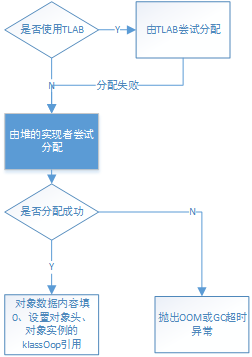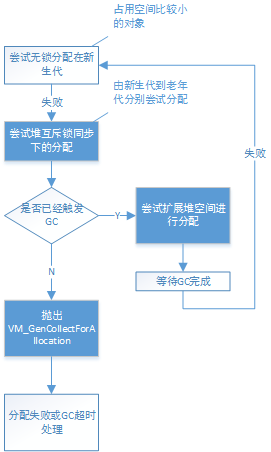源码分析:Java对象的内存分配(1)(2)
二、慢速分配
接下来看看慢速分配是如何进行的:
1.InterpreterRuntime的_new函数定义在/hotspot/src/share/vm/interpreter/interpreterRuntime.cpp中:
- IRT_ENTRY(void, InterpreterRuntime::_new(JavaThread* thread, constantPoolOopDesc* pool, int index))
- klassOop k_oop = pool->klass_at(index, CHECK);
- instanceKlassHandle klass (THREAD, k_oop);
- // Make sure we are not instantiating an abstract klass
- klass->check_valid_for_instantiation(true, CHECK);
- // Make sure klass is initialized
- klass->initialize(CHECK);
- oop obj = klass->allocate_instance(CHECK);
- thread->set_vm_result(obj);
- IRT_END
该函数在进行了对象类的检查(确保不是抽象类)和对该类型进行初始化后,调用instanceKlassHandle的allocate_instance进行内存分配。
其中instanceKlassHandle类由DEF_KLASS_HANDLE宏进行声明,注意该类重载了成员访问运算符”->”,这里的一系列成员方法的访问实际上是instanceKlass对象的访问。
type* operator -> () const { return (type*)obj()->klass_part(); }
2.所以实际上是调用了instanceKlass的allocate_instance()成员函数:
allocate_instance()定义在/hotspot/src/share/vm/oops/instanceKlass.cpp
(1).检查是否设置了Finalizer函数,获取对象所需空间的大小
- instanceOop instanceKlass::allocate_instance(TRAPS) {
- bool has_finalizer_flag = has_finalizer(); // Query before possible GC
- int size = size_helper(); // Query before forming handle.
(2).调用CollectedHeap的obj_allocate()创建一个instanceOop(堆上的对象实例),并根据情况注册Finalizer函数
- KlassHandle h_k(THREAD, as_klassOop());
- instanceOop i;
- i = (instanceOop)CollectedHeap::obj_allocate(h_k, size, CHECK_NULL);
- if (has_finalizer_flag && !RegisterFinalizersAtInit) {
- i = register_finalizer(i, CHECK_NULL);
- }
- return i;
3.CollectedHeap::ojb_allocate()定义在/hotspot/src/share/vm/gc_interface/CollectedHeap.hpp中,它将转而调用内联函数obj_allocate()
4.obj_allocate()定义在/hotspot/src/share/vm/gc_interface /CollectedHeap.inline.h中,若当正处于gc状态时,不允许进行内存分配申请,否则将调用 common_mem_allocate_init()进行内存分配并返回获得内存的起始地址,随后将调用 post_allocation_setup_obj()进行一些初始化工作
- oop CollectedHeap::obj_allocate(KlassHandle klass, int size, TRAPS) {
- //...assert
- HeapWord* obj = common_mem_allocate_init(size, false, CHECK_NULL);
- post_allocation_setup_obj(klass, obj, size);
- NOT_PRODUCT(Universe::heap()->check_for_bad_heap_word_value(obj, size));
- return (oop)obj;
- }
5.common_mem_allocate_init()分为两部分,将分别调用common_mem_allocate_noinit()进行内存空间的分配和调用init_obj()进行对象空间的初始化
- HeapWord* CollectedHeap::common_mem_allocate_init(size_t size, bool is_noref, TRAPS) {
- HeapWord* obj = common_mem_allocate_noinit(size, is_noref, CHECK_NULL);
- init_obj(obj, size);
- return obj;
- }
6.common_mem_allocate_noinit()如下:
(1).若使用了本地线程分配缓冲TLAB,则会调用allocate_from_tlab()尝试从TLAB中分配内存
(2).否则会调用堆的mem_allocate()尝试分配
- HeapWord* result = NULL;
- if (UseTLAB) {
- result = CollectedHeap::allocate_from_tlab(THREAD, size);
- if (result != NULL) {
- assert(!HAS_PENDING_EXCEPTION,
- "Unexpected exception, will result in uninitialized storage"); return result;
- }
- }
- bool gc_overhead_limit_was_exceeded = false;
- result = Universe::heap()->mem_allocate(size,
- is_noref,
- false,
- &gc_overhead_limit_was_exceeded);
(3).统计分配的字节数
- if (result != NULL) {
- //...
- THREAD->incr_allocated_bytes(size * HeapWordSize);
- return result;
- }
(4).否则说明申请失败,若在申请过程中gc没有超时,则抛出OOM异常
- if (!gc_overhead_limit_was_exceeded) {
- // -XX:+HeapDumpOnOutOfMemoryError and -XX:OnOutOfMemoryError support
- report_java_out_of_memory("Java heap space"); if (JvmtiExport::should_post_resource_exhausted()) { JvmtiExport::post_resource_exhausted( JVMTI_RESOURCE_EXHAUSTED_OOM_ERROR | JVMTI_RESOURCE_EXHAUSTED_JAVA_HEAP, "Java heap space");
- }
- THROW_OOP_0(Universe::out_of_memory_error_java_heap());
7.对象内存分配后的初始化过程包括两部分,一个是init_obj()完成对对象内存空间的对齐和填充,一个是post_allocation_setup_obj()对堆上的oop对象进行初始化。
(1).init_obj():
- void CollectedHeap::init_obj(HeapWord* obj, size_t size) {
- assert(obj != NULL, "cannot initialize NULL object"); const size_t hs = oopDesc::header_size(); assert(size >= hs, "unexpected object size"); ((oop)obj)->set_klass_gap(0); Copy::fill_to_aligned_words(obj + hs, size - hs);
- }
hs就是对象头的大小,fill_to_aligned_words将对象空间除去对象头的部分做填0处理,该函数定义在/hotspot /src/share/vm/utilities/copy.h中,并转而调用pd_fill_to_aligned_words()。
pd_fill_to_aligned_words根据不同平台实现,以x86平台为例,该函数定义在/hotspot/src/cpu/x86/vm/copy_x86.h中:
- static void pd_fill_to_words(HeapWord* tohw, size_t count, juint value) {
- #ifdef AMD64
- julong* to = (julong*) tohw;
- julong v = ((julong) value << 32) | value;
- while (count-- > 0) {
- *to++ = v;
- }
- #else
- juint* to = (juint*)tohw;
- count *= HeapWordSize / BytesPerInt;
- while (count-- > 0) {
- *to++ = value;
- }
- #endif // AMD64
- }
该函数的作用就是先将地址类型转换,然后把堆的字数转化为字节数,再对该段内存进行填值(value = 0)处理
(2).post_allocation_setup_obj()调用了post_allocation_setup_common()进行初始化工作,然后调用post_allocation_notify()通知JVMTI和dtrace
- void CollectedHeap::post_allocation_setup_obj(KlassHandle klass,
- HeapWord* obj,
- size_t size) {
- post_allocation_setup_common(klass, obj, size);
- assert(Universe::is_bootstrapping() ||
- !((oop)obj)->blueprint()->oop_is_array(), "must not be an array"); // notify jvmti and dtrace post_allocation_notify(klass, (oop)obj);
- }
post_allocation_setup_common()如下:
- void CollectedHeap::post_allocation_setup_common(KlassHandle klass,
- HeapWord* obj,
- size_t size) {
- post_allocation_setup_no_klass_install(klass, obj, size);
- post_allocation_install_obj_klass(klass, oop(obj), (int) size);
- }
post_allocation_setup_no_klass_install()根据是否使用偏向锁,设置对象头信息等,即初始化oop的 _mark字段。post_allocation_install_obj_klass()设置对象实例的klassOop引用,即初始化oop的 _metadata(_klass/_compressed_klass)字段 。
以上内容就是堆实现无关的慢速分配过程,其流程图如下:

三、堆的分配实现
1.mem_allocate将由堆的实现类型定义,以GenCollectedHeap为例:
- HeapWord* GenCollectedHeap::mem_allocate(size_t size,
- bool is_large_noref,
- bool is_tlab,
- bool* gc_overhead_limit_was_exceeded) {
- return collector_policy()->mem_allocate_work(size,
- is_tlab,
- gc_overhead_limit_was_exceeded);
- }
2.由之前分析,GenCollectedHeap根据用户配置有着不同的GC策略(默认的和配置UseSerialGC的 MarkSweepPolicy、配置UseComcMarkSweepGC和UseAdaptiveSizePolicy的 ASConcurrentMarkSweepPolicy、只配置UseComcMarkSweepGC的 ConcurrentMarkSweepPolicy),但这里,对象内存空间的基本结构和分配的思想是一致的,所以统一由 GenCollectorPolicy实现进行分代层级的对象分配操作,但具体的工作将交由各代的实现者来完成。
GenCollectedPolicy的mem_allocate_work()函数如下:
(1).gch指向GenCollectedHeap堆,内存分配请求将循环不断地进行尝试,直到分配成功或GC后分配失败
- HeapWord* GenCollectorPolicy::mem_allocate_work(size_t size,
- bool is_tlab,
- bool* gc_overhead_limit_was_exceeded) {
- GenCollectedHeap *gch = GenCollectedHeap::heap();
- //...
- // Loop until the allocation is satisified,
- // or unsatisfied after GC.
- for (int try_count = 1; /* return or throw */; try_count += 1) {
对于占用空间比较大的对象,如果经常放在新生代,那么剩余的内存空间就会非常紧张,将可能会导致新生代内存垃圾回收的频繁触发。故若对象的大小超过一定值,那么就不应该分配在新生代。
- //...紧接上面部分
- dleMark hm; // discard any handles allocated in each iteration
- // First allocation attempt is lock-free.
- Generation *gen0 = gch->get_gen(0);
- if (gen0->should_allocate(size, is_tlab)) {
- result = gen0->par_allocate(size, is_tlab);
- if (result != NULL) {
- assert(gch->is_in_reserved(result), "result not in heap"); return result;
- }
- }
若对象应该在新生代上分配,就会调用新生代的par_allocate()进行分配,注意在新生代普遍是采用复制收集器的,而内存的分配对应采用了无锁式的指针碰撞技术。
(2).在新生代上尝试无锁式的分配失败,那么就获取堆的互斥锁,并尝试在各代空间内进行内存分配
- unsigned int gc_count_before; // read inside the Heap_lock locked region
- {
- MutexLocker ml(Heap_lock);
- //...
- bool first_only = ! should_try_older_generation_allocation(size);
- result = gch->attempt_allocation(size, is_tlab, first_only);
- if (result != NULL) {
- assert(gch->is_in_reserved(result), "result not in heap"); return result;
- }
其中should_try_older_generation_allocation()如下:
- bool GenCollectorPolicy::should_try_older_generation_allocation(
- size_t word_size) const {
- GenCollectedHeap* gch = GenCollectedHeap::heap();
- size_t gen0_capacity = gch->get_gen(0)->capacity_before_gc();
- return (word_size > heap_word_size(gen0_capacity))
- || GC_locker::is_active_and_needs_gc()
- || gch->incremental_collection_failed();
- }
当进行gc前,新生代的空闲空间大小不足以分配对象,或者有线程触发了gc,或前一次的FullGC是由MinorGC触发的情况,都应该不再尝试再更高的内存代上进行分配,以保证新分配的对象尽可能在新生代空间上。
attempt_allocation()实现如下:
- HeapWord* GenCollectedHeap::attempt_allocation(size_t size,
- bool is_tlab,
- bool first_only) {
- HeapWord* res;
- for (int i = 0; i < _n_gens; i++) {
- if (_gens[i]->should_allocate(size, is_tlab)) {
- res = _gens[i]->allocate(size, is_tlab);
- if (res != NULL) return res;
- else if (first_only) break;
- }
- }
- // Otherwise...
- return NULL;
- }
即由低内存代向高内存代尝试分配内存
(3).从各个代空间都找不到可用的空闲内存(或不应该在更高的内存代上分配时),如果已经有线程触发了gc,那么当各代空间还有virtual space可扩展空间可用时,将会尝试扩展代空间并再次尝试进行内存分配,有点在gc前想尽一切办法获得内存的意思。
- if (GC_locker::is_active_and_needs_gc()) {
- if (is_tlab) {
- return NULL; // Caller will retry allocating individual object
- }
- if (!gch->is_maximal_no_gc()) {
- // Try and expand heap to satisfy request
- result = expand_heap_and_allocate(size, is_tlab);
- // result could be null if we are out of space
- if (result != NULL) {
- return result;
- }
- }
(4).否则各代已经没有可用的可扩展空间时,当当前线程没有位于jni的临界区时,将释放堆的互斥锁,以使得请求gc的线程可以进行gc操作,等待所有本地线程退出临界区和gc完成后,将继续循环尝试进行对象的内存分配
- JavaThread* jthr = JavaThread::current();
- if (!jthr->in_critical()) {
- MutexUnlocker mul(Heap_lock);
- // Wait for JNI critical section to be exited
- GC_locker::stall_until_clear();
- continue;
- }
(5).若各代无法分配对象的内存,并且没有gc被触发,那么当前请求内存分配的线程将发起一次gc,这里将提交给VM一个 GenCollectForAllocation操作以触发gc,当操作执行成功并返回时,若gc锁已被获得,那么说明已经由其他线程触发了gc,将继续 循环以等待gc完成
否则将等待gc完成,若gc超时则会将gc_overhead_limit_was_exceeded设置为true返回给调用者,并重置超时状态,并对分配的对象进行填充处理
- VM_GenCollectForAllocation op(size,
- is_tlab,
- gc_count_before);
- VMThread::execute(&op);
- if (op.prologue_succeeded()) {
- result = op.result();
- if (op.gc_locked()) {
- assert(result == NULL, "must be NULL if gc_locked() is true"); continue; // retry and/or stall as necessary
- }
- const bool limit_exceeded = size_policy()->gc_overhead_limit_exceeded();
- const bool softrefs_clear = all_soft_refs_clear();
- assert(!limit_exceeded || softrefs_clear, "Should have been cleared"); if (limit_exceeded && softrefs_clear) { *gc_overhead_limit_was_exceeded = true; size_policy()->set_gc_overhead_limit_exceeded(false); if (op.result() != NULL) { CollectedHeap::fill_with_object(op.result(), size); } return NULL;
- }
以上内容就是堆的实现相关、但代/GC实现无关的分配过程,其流程图归纳如下:


用户点评